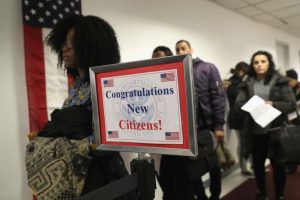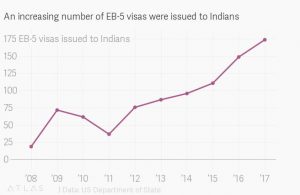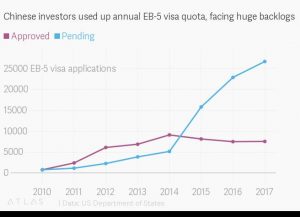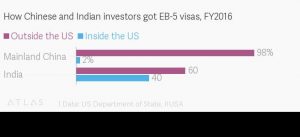JULY 12, 2018
 Immigrants wait in line to become US citizens at a naturalization ceremony on February 2, 2018 in New York City. U.S. Citizenship and Immigration Services (USCIS) swore in 128 immigrants from 42 different countries during the ceremony at the downtown Manhattan Federal Building. – Getty
Immigrants wait in line to become US citizens at a naturalization ceremony on February 2, 2018 in New York City. U.S. Citizenship and Immigration Services (USCIS) swore in 128 immigrants from 42 different countries during the ceremony at the downtown Manhattan Federal Building. – Getty
The wealthy Chinese have been paying hundreds of thousands of dollars to effectively buy legal US residency. Now it’s a tactic taking off with Indians. The US will grant permanent residency, colloquially known as a green card, to foreign nationals who invest as little as $500,000 into the US economy. This “investor visa” is known as the EB‑5.
Investors from mainland China have received the vast majority of these visas in the past decade. However, growth in applications from Chinese nationals has nearly stopped due to the staggering visa backlogs they face. India, currently the third largest country of EB-5 investors, has became the new focus of efforts by US real estate developers and businesses, to secure investment from abroad. India is rapidly catching up.
The number keeps increasing. There were 307 Indian investors waiting in the EB-5 visa queue by November 2017, according to a US Department of State report (pdf, p. 11). Those are folks who had submitted their applications but haven’t gained approval yet. Rogelio Caceres, the co-founder of LCR Capital Partners—a company that connects foreigners with money to EB-5-eligible investment projects—told Quartz that his company is working with about 200 Indian clients. He estimated that 500 to 800 Indians were applying or would apply for EB-5 visas this year, and more than 1,000 would apply in 2019.
Growth with Indians thanks to visa backlogs for Chinese
Caceres’s company has helped Indians get EB-5 visas for years, but the market didn’t take off until 2017. That was when the popularity for EB-5 visas among Chinese slowed. US real estate developers, in turn, directed its marketing efforts towards attracting investors from other countries when seeking cash for their projects.
 Issuance of EB-5 visas is capped at 10,000 annually. Any single country’s applicants can only take up 700 of the 10,000. If a country doesn’t hit its cap, the unused visas under the cap can be redistributed to people from countries that did.
Issuance of EB-5 visas is capped at 10,000 annually. Any single country’s applicants can only take up 700 of the 10,000. If a country doesn’t hit its cap, the unused visas under the cap can be redistributed to people from countries that did.
Mainland-born Chinese nationals enjoying their new wealth from a decade-long economic expansion flocked to the program. They took 75% of all EB-5 visas from 2008 to 2017. In the process, they created a huge backlog of applications.
Charlie Oppenheim, the chief of the Visa Control and Reporting Division at US Department of State, estimated in April that an EB-5 application from China would take 15 years to get processed. The significant delay has discouraged Chinese investors and slowed the growth of applications from the country.
 Despite the low number of existing EB-5 investors in India, real estate developers and investment firms quickly saw an opportunity: India would be the next biggest market for EB-5 investors. All they need to do is to spread the word.
Despite the low number of existing EB-5 investors in India, real estate developers and investment firms quickly saw an opportunity: India would be the next biggest market for EB-5 investors. All they need to do is to spread the word.
“Wealthy Indians had no idea two or three years ago that they could get a green card by investing in a business or a real estate project,” said Careers. The marketing efforts raised awareness; the success of prior applications instilled confidence; then Indians acted on it.
 A sign welcomes people to the U.S. from Mexico on June 25, 2018 in Brownsville, Texas. Immigration has once again been put in the spotlight as Democrats and Republicans spar over the detention of children and families seeking asylum at the border. Before President Donald Trump signed an executive order last week that halts the practice of separating families who are seeking asylum, more than 2,300 immigrant children had been separated from their parents in the zero-tolerance policy for border crossers. – Getty
A sign welcomes people to the U.S. from Mexico on June 25, 2018 in Brownsville, Texas. Immigration has once again been put in the spotlight as Democrats and Republicans spar over the detention of children and families seeking asylum at the border. Before President Donald Trump signed an executive order last week that halts the practice of separating families who are seeking asylum, more than 2,300 immigrant children had been separated from their parents in the zero-tolerance policy for border crossers. – Getty
Indians applicants are different from Chinese
Like China, India has a fast growing economy. Also like the Chinese, there’s significant interest among Indians to immigrate to the US. However, the EB-5 visa investors from India are showing to be very different from those from China.
The typical Chinese investor lives in China and applies for the visa through a US consulate. Nearly all EB-5 visa applicants from China applied for the visa while outside of the US in fiscal year 2016.
 Almost half of Indians applying for EB-5s in 2016 were already US visa holders. Some were studying at US educational institutions on student visas. A student’s well-off parents, perhaps hoping for their kid’s academic and professional success, could give the money to secure a green card. Others are skilled workers employed by US companies on H-1B visas. It could take up to 70 years for Indian nationals to convert their H-1B work visa into a green card. The costly EB-5 program is a faster option.
Almost half of Indians applying for EB-5s in 2016 were already US visa holders. Some were studying at US educational institutions on student visas. A student’s well-off parents, perhaps hoping for their kid’s academic and professional success, could give the money to secure a green card. Others are skilled workers employed by US companies on H-1B visas. It could take up to 70 years for Indian nationals to convert their H-1B work visa into a green card. The costly EB-5 program is a faster option.
Unlike people from China, there’s currently no backlog for Indians. “If they apply today, they can get a green card under two years,” said Caceres.
Courtesy: Quartz










































































































